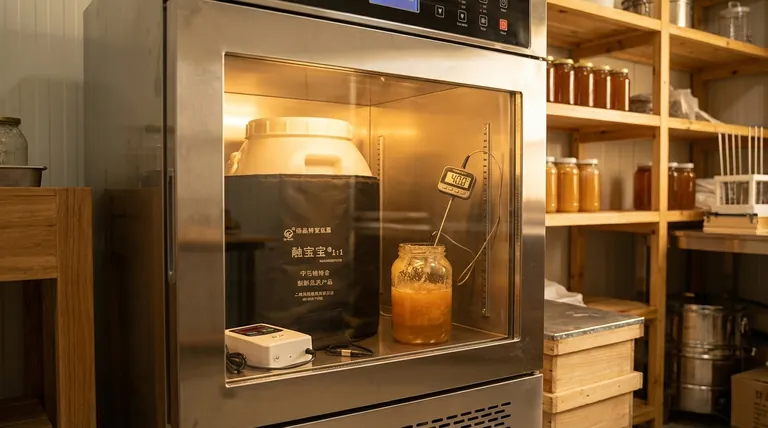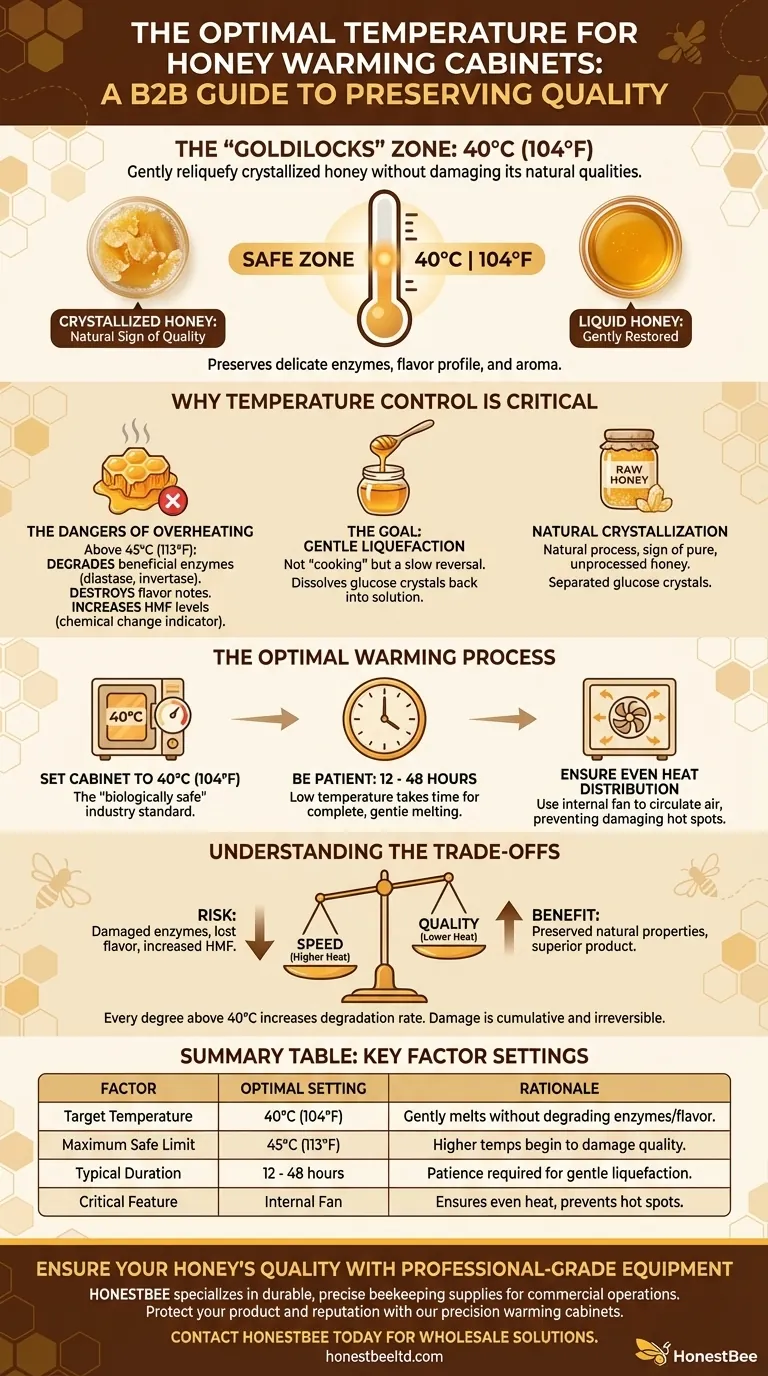The ideal temperature for a honey warming cabinet is a precise balance. To reliquefy crystallized honey without damaging its natural qualities, you should set the temperature to approximately 40°C (104°F). This temperature is warm enough to gently melt the glucose crystals but cool enough to preserve the honey's delicate enzymes, flavor profile, and aroma.
Crystallization is a natural sign of high-quality raw honey, not a flaw. The goal of a warming cabinet is not simply to melt the honey, but to do so gently, preserving the very properties that make it valuable. Exceeding a safe temperature threshold permanently degrades the honey.

Why Temperature Control is Critical for Honey
Honey is a sensitive biological product. The temperature you use to warm it has a direct and irreversible impact on its quality. Understanding the "why" behind the recommended temperature is key to properly handling your product.
The Natural Process of Crystallization
Crystallization is the process of glucose, one of the main sugars in honey, separating from the water and forming tiny crystals. This is a completely natural phenomenon and is often a sign of pure, unprocessed honey. The tendency to crystallize is primarily determined by the honey's specific floral source and its glucose-to-fructose ratio.
The Goal: Gentle Liquefaction
The purpose of warming honey is to gently dissolve these glucose crystals back into the solution, returning the honey to its liquid state. This is not "cooking" but rather a slow, controlled reversal of a natural process.
The Dangers of Overheating
When honey is heated excessively, its fundamental chemistry begins to change. Temperatures above 45°C (113°F) start to degrade beneficial enzymes, such as diastase and invertase, which are key markers of raw honey. This heat also destroys the subtle and complex flavor notes and can darken the honey's color.
Furthermore, overheating dramatically increases the levels of Hydroxymethylfurfural (HMF), a compound formed from the breakdown of sugars. While not harmful in small amounts, high HMF levels are a clear indicator that the honey has been subjected to excessive heat or is very old.
The Optimal Warming Process
Achieving a perfect liquid state without compromising quality requires a combination of the right temperature and sufficient time.
The "Safe Zone": 40°C (104°F)
The recommended temperature of 40°C (104°F) is the industry-standard sweet spot. This temperature is similar to what might be found inside a bustling beehive on a very hot summer day, making it a "biologically safe" level for the honey. At this temperature, liquefaction occurs without significant enzyme degradation or HMF production.
The Importance of Patience
Low-temperature warming is not a fast process. Depending on the size of the container and the extent of the crystallization, it can take anywhere from 12 to 48 hours to fully liquefy the honey. Rushing the process with higher heat will always come at the cost of quality.
Ensuring Even Heat Distribution
For a cabinet to be effective, heat must be distributed evenly. Many cabinets rely on a simple heating element, which can create hot spots that damage the honey nearby before the rest of the container has melted. Using a small internal fan to circulate the air is critical for maintaining a consistent temperature throughout the cabinet.
Understanding the Trade-offs
When warming honey, you are constantly managing a trade-off between speed and quality.
Heat vs. Time
This is the central compromise. You can melt honey in a few hours at a high temperature, but you will be left with a product that has lost much of its enzymatic value and flavor complexity. The professional standard is to prioritize quality, which means accepting a longer, slower process at a lower temperature.
Risk of Damaging Natural Qualities
Every degree above the safe zone increases the rate of degradation. While a brief period at 45°C (113°F) may have a minor impact, prolonged exposure or higher temperatures will permanently alter the honey. The damage is cumulative and irreversible.
Equipment Accuracy
Do not blindly trust the dial on your warming cabinet. Many thermostats, especially on DIY or lower-cost models, can be inaccurate by several degrees. Always place an independent, calibrated thermometer inside the cabinet to verify the true ambient temperature your honey is being exposed to.
Setting Your Cabinet for Optimal Results
Use these guidelines to configure your warming process based on your specific goals.
- If your primary focus is preserving raw honey quality: Set your cabinet to 40°C (104°F), use an internal fan for circulation, and plan for a 24-48 hour cycle to ensure gentle, complete liquefaction.
- If you are in a time-sensitive situation: You can push the temperature to 45°C (113°F) to speed up the process, but be aware that you are beginning to trade a small amount of quality for that speed.
- If you are dealing with creamed or spun honey: Do not heat it. The desirable texture of creamed honey comes from a controlled process of creating very fine crystals, which will be destroyed by warming.
By carefully controlling the temperature, you ensure your honey remains as natural and flavorful as the day it was harvested.
Summary Table:
| Key Factor | Optimal Setting | Rationale |
|---|---|---|
| Target Temperature | 40°C (104°F) | Gently melts crystals without degrading enzymes or flavor. |
| Maximum Safe Limit | 45°C (113°F) | Higher temperatures begin to damage honey quality. |
| Typical Duration | 12 - 48 hours | Low temperature requires patience for complete, gentle liquefaction. |
| Critical Feature | Internal Fan | Ensures even heat distribution to prevent damaging hot spots. |
Ensure Your Honey's Quality with Professional-Grade Equipment
Are you a commercial apiary or beekeeping equipment distributor looking to scale your honey processing while guaranteeing the highest quality? HONESTBEE specializes in supplying durable, precise, and efficient beekeeping supplies and equipment through wholesale-focused operations.
We understand that the integrity of your honey is your reputation. Our warming cabinets are designed with the precise temperature control and even heat distribution necessary to protect the delicate enzymes and flavor profiles of raw honey.
Let us help you protect your product and grow your business.
Contact HONESTBEE today to discuss wholesale solutions for your commercial beekeeping needs.
Visual Guide

Related Products
- Honey Tank Heater Drum Heating Blanket for Honey Barrel
- Beeswax Melter for Candle Making Honey Bee Wax Melter
- Professional Cone-Shaped Honey Filter with Reinforced Steel Ring
- Natural Wood Honey Dipper for Tea Coffee and Desserts
- 10L Stainless Steel Electric Honey Press Machine
People Also Ask
- How can crystallized honey be restored to a liquid state? A Beekeeper's Guide to Gentle Re-liquefaction
- What is heat treatment for honey? A Guide to Liquefying, Pasteurizing, and Preserving Quality
- What are the benefits of a honey heating tank? Achieve Crystal-Clear, Market-Ready Honey
- Why is a honey bucket warmer considered a valuable tool for honey storage? Preserve Quality & Streamline Bottling
- How do you use a honey warmer? A Guide to Safe, Gentle Honey Decrystallization



















